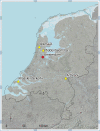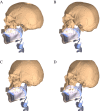The vocal tract as a time machine: inferences about past speech and language from the anatomy of the speech organs
- PMID: 33745306
- PMCID: PMC8059537
- DOI: 10.1098/rstb.2020.0192
The vocal tract as a time machine: inferences about past speech and language from the anatomy of the speech organs
Abstract
While speech and language do not fossilize, they still leave traces that can be extracted and interpreted. Here, we suggest that the shape of the hard structures of the vocal tract may also allow inferences about the speech of long-gone humans. These build on recent experimental and modelling studies, showing that there is extensive variation between individuals in the precise shape of the vocal tract, and that this variation affects speech and language. In particular, we show that detailed anatomical information concerning two components of the vocal tract (the lower jaw and the hard palate) can be extracted and digitized from the osteological remains of three historical populations from The Netherlands, and can be used to conduct three-dimensional biomechanical simulations of vowel production. We could recover the signatures of inter-individual variation between these vowels, in acoustics and articulation. While 'proof-of-concept', this study suggests that older and less well-preserved remains could be used to draw inferences about historic and prehistoric languages. Moreover, it forces us to clarify the meaning and use of the uniformitarian principle in linguistics, and to consider the wider context of language use, including the anatomy, physiology and cognition of the speakers. This article is part of the theme issue 'Reconstructing prehistoric languages'.
Keywords: language change; osteology; phonetics; vocal tract.
Figures


References
-
- Boë L-J, Heimb J-L, Hondac K, Maeda S. 2002. The potential Neandertal vowel space was as large as that of modern humans. J. Phon. 30, 465-484. (10.1006/jpho.2002.0170) - DOI
-
- de Boer B, Fitch WT. 2010. Computer models of vocal tract evolution: an overview and critique. Adapt. Behav. 18, 36-47. (10.1177/1059712309350972) - DOI
-
- Janssen R, Moisik SR, Dediu D. 2019. The effects of larynx height on vowel production are mitigated by the active control of articulators. J. Phon. 74, 1-17. (10.1016/j.wocn.2019.02.002) - DOI
-
- Lieberman P, Crelin ES, Klatt DH. 1972. Phonetic ability and related anatomy of the newborn and adult human, Neanderthal man, and the chimpanzee. Am. Anthropol. 74, 287-307. (10.1525/aa.1972.74.3.02a00020) - DOI
Publication types
MeSH terms
Associated data
LinkOut - more resources
Full Text Sources
Other Literature Sources
Miscellaneous
